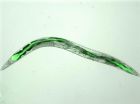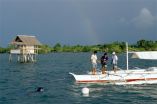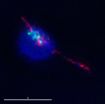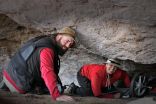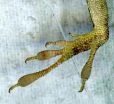(Press-News.org) Orono, Maine — In the southern Peruvian Andes, an archaeological team led by researchers at the University of Maine has documented the highest altitude ice age human occupation anywhere in the world — nearly 4,500 meters above sea level (masl).
Their discoveries date high-altitude human habitation nearly a millennium earlier than previously documented.
Despite cold temperatures, high solar radiation and low oxygen conditions at that altitude, hunter-gatherers colonized the remote, treeless landscapes about 12,000 years ago during the terminal Pleistocene — within 2,000 years after humans arrived in South America.
"Study of human adaptation to extreme environments is important in understanding our cultural and genetic capacity for survival," according to the research team, led by Kurt Rademaker, a University of Maine visiting assistant professor in anthropology, writing in the journal Science.
The Pucuncho archaeological site, 4,355 masl, included 260 formal tools, such as projectile points, nondiagnostic bifaces and unifacial scrapers up to 12,800 years old. Cuncaicha rockshelter, featuring two alcoves at 4,480 masl, contains a "robust, well-preserved and well-dated occupation sequence" up to 12,400 years old. The rockshelter, with views of wetland and grassland habitats, features sooted ceilings and rock art, and was likely a base camp.
Most of the lithic tools at Cuncaicha were made from locally available obsidian, andesite and jasper, and are indicative of hunting and butchering consistent with limited subsistence options on the plateau, according to the researchers. In addition to plant remains, bones at the site indicate hunting of vicuña and guanaco camelids and the taruca deer.
Pucuncho Basin was a high-altitude oasis for specialized hunting, particularly of vicuña, and later, herding of domesticated alpacas and llamas. While the Pucuncho Basin could have sustained year-round residence, wet-season storms and the dangers of hypothermia, as well as the need to maintain extended social networks and collection of edible plants, may have encouraged regular descents, according to the research team.
In addition, the lithic tools and debitage included nonlocal, fine-grained rocks — some stream-polished. That would have required the plateau residents to visit high-energy rivers in the lower elevations.
It is unclear whether the high-altitude human settlement required genetic or environmental adaptations. But with evidence of high-altitude human habitation almost 900 years earlier than previously documented, the implication is that there may have been more moderate late-glacial Andean environments and greater physiological capabilities for Pleistocene humans.
"The Pucuncho Basin sites suggest that Pleistocene humans lived successfully at extreme high altitude, initiating organismal selection, developmental functional adaptations and lasting biogeographic expansion in the Andes," write the researchers. "As new studies identify potential genetic signatures of high-altitude adaptation in modern Andean populations, comparative genomic, physiologic and archaeological research will be needed to understand when and how these adaptations evolved."
INFORMATION:
In addition to Rademaker, who received his Ph.D. from UMaine in 2012 and is now a postdoctoral researcher at the University of Tübingen, the research team members are: Gregory Hodgins, University of Arizona; Katherine Moore, University of Pennsylvania; Sonia Zarrillo, University of Calgary; Christopher Miller, University of Tübingen; Peter Leach, University of Connecticut; David Reid, University of Illinois-Chicago; Willy Yépez Álvarez, Peru; and Gordon Bromley and Daniel Sandweiss, University of Maine.
The team's research was supported by the Dan and Betty Churchill Exploration Fund at the University of Maine, the National Geographic Society/Waitt Grants Program, and the National Science Foundation.
Highest altitude ice age human occupation documented in Peruvian Andes
Discovery by UMaine-led team dates high-altitude habitation nearly a millennium earlier than previously documented
2014-10-23
ELSE PRESS RELEASES FROM THIS DATE:
TSRI chemists achieve new technique with profound implications for drug development
2014-10-23
LA JOLLA, CA – October 23, 2014 - Breaking carbon-hydrogen (C-H) bonds to alter existing molecules to create new ones is an increasingly important avenue for drug development. Of particular interest is mirror-image or "one-handed" compounds, but C-H breaking methods for making pure batches of these molecules have worked with only a limited range of starting materials.
Now a team from The Scripps Research Institute (TSRI) has established a new C-H activation technique that opens the door to creating a broader range of pure molecules of one-handedness or "chirality" ...
Gene identified for immune system reset after infection
2014-10-23
DURHAM, N.C. -- When pathogenic bacteria like Salmonella or Staphylococcus invade a host, the host organism should respond by going into a state of high alert, altering its metabolism to defend against the attack.
But if the host doesn't reverse course once the battle is won, its efforts will be wasted on defense rather than on repairing the damage done by bacterial invaders.
Duke University researchers have uncovered the genes that are normally activated during recovery from bacterial infection. The finding could lead to ways to jumpstart this recovery process and ...
New microscope collects dynamic images of the molecules that animate life
2014-10-23
Over the last decade, powerful new microscopes have dramatically sharpened biologists' focus on the molecules that animate and propel life. Now, a new imaging platform developed by Eric Betzig and colleagues at the Howard Hughes Medical Institute's Janelia Research Campus offers another leap forward for light microscopy. The new technology collects high-resolution images rapidly and minimizes damage to cells, meaning it can image the three-dimensional activity of molecules, cells, and embryos in fine detail over longer periods than was previously possible.
The developers ...
Top marine scientists call for action on 'invisible' fisheries
2014-10-23
To protect our oceans from irreversible harm, governments, conservationists, and researchers around the world must address the enormous threat posed by unregulated and destructive fisheries, say top marine scientists.
In an article published today in Science, Prof. Amanda Vincent of Project Seahorse at the University of British Columbia and Dr. Jean M. Harris of Ezemvelo KZN Wildlife in South Africa call for bold new approaches to the pressing global issue of overfishing and habitat destruction, including networks of marine protected areas, co-ordinated governance, and ...
Flu viruses disguised as waste
2014-10-23
This news release is available in German. Viral infections always follow a similar course. The pathogen infiltrates the host cells and uses their replication and protein production machinery to multiply. The virus has to overcome the initial barrier by docking on the surface of the cell membrane. The cell engulfs the virus in a bubble and transports it towards the cell nucleus. During this journey, the solution inside the bubble becomes increasingly acidic. The acidic pH value is ultimately what causes the virus's outer shell to melt into the membrane of the bubble.
Capsid ...
Genetic causes underlying the disqualification of 2 elite American Standardbred pacers
2014-10-23
A DNA mutation that can lead to horses being genetically male, but female in appearance, may explain at least two cases of controversial sexual identity, according to research led by professors from the Texas A&M College of Veterinary Medicine & Biomedical Sciences (CVM) and published in PLOS Genetics.
This type of genetic abnormality is caused by a mutation called DNA copy number variation (CNV), in which there are deletions and duplications in the genome typically larger than 50 base pairs.
These variations are one way that individuals of the same species are genetically ...
Cutting the ties that bind
2014-10-23
Kansas City, MO. — The development of a new organism from the joining of two single cells is a carefully orchestrated endeavor. But even before sperm meets egg, an equally elaborate set of choreographed steps must occur to ensure successful sexual reproduction. Those steps, known as reproductive cell division or meiosis, split the original number of chromosomes in half so that offspring will inherit half their genetic material from one parent and half from the other.
During meiosis, each set of homologous chromosomes pair up in a kind of chromosomal square dance, ...
Scientists uncover how protein ensures reproductive success
2014-10-23
An international team of researchers from Japan and the UK has discovered how a single protein, called PP4, oversees the processing of DNA during sperm and egg generation for successful fertilization. This protein's activity becomes even more paramount during aging. The study, published in the journal PLOS Genetics, may one day help scientists to understand the mechanisms underlying age-related fertility declines in humans.
While a typical adult human cell contains 46 DNA strands, or chromosomes, that carry our complete genetic information, reproductive cells such as ...
Highest altitude archaeological sites in the world explored in the Peruvian Andes
2014-10-23
Research conducted at the highest-altitude Pleistocene archaeological sites yet identified in the world sheds new light on the capacity of humans to survive in extreme environments.
The findings, to be published in the Oct. 24 edition of the academic journal Science – co-authored by a team of researchers including University of Calgary archaeologist Sonia Zarrillo – were taken from sites in the Pucuncho Basin, located in the Southern Peruvian Andes.
The primary site, Cuncaicha is a rock shelter at 4,480 metres above sea level, with a stone-tool workshop ...
Florida lizards evolve rapidly, within 15 years and 20 generations
2014-10-23
Scientists working on islands in Florida have documented the rapid evolution of a native lizard species — in as little as 15 years — as a result of pressure from an invading lizard species, introduced from Cuba.
After contact with the invasive species, the native lizards began perching higher in trees, and, generation after generation, their feet evolved to become better at gripping the thinner, smoother branches found higher up.
The change occurred at an astonishing pace: Within a few months, native lizards had begun shifting to higher perches, and over ...
LAST 30 PRESS RELEASES:
ETRI develops an automated benchmark for labguage-based task planners
Revolutionizing memory technology: multiferroic nanodots for low-power magnetic storage
Researchers propose groundbreaking framework for future network systems
New favorite—smart electric wheel drive tractor: realizes efficient drive with ingenious structure and intelligent control
Using stem cell-derived heart muscle cells to advance heart regenerative therapy
Damon Runyon Cancer Research Foundation awards Quantitative Biology Fellowships to four cutting-edge scientists
Climb stairs to live longer
Scientists capture X-rays from upward positive lightning
AMS Science Preview: Hawaiian climates; chronic pain; lightning-caused wildfires
Researchers advance detection of gravitational waves to study collisions of neutron stars and black holes
Automated machine learning robot unlocks new potential for genetics research
University of Toronto scientists appointed as GSK chairs will advance drug delivery research and vaccine education tools for healthcare professionals
Air pollution and depression linked with heart disease deaths in middle-aged adults
More efficient molecular motor widens potential applications
Robotic nerve ‘cuffs’ could help treat a range of neurological conditions
Researchers identify targets in the brain to modulate heart rate and treat depressive disorders
Findings of large-scale study on 572 Asian families supports gene-directed management of BRCA1 and BRCA2 gene carriers in Singapore
Many children with symptoms of brain injuries and concussions are missing out on vital checks, national US study finds
Genetic hope in fight against devastating wheat disease
Mutualism, from biology to organic chemistry?
POSTECH Professor Yong-Young Noh resolves two decades of oxide semiconductor challenges, which Is published in prestigious journal Nature
Could fishponds help with Hawaiʻi’s food sustainability?
International network in Asia and Europe to uncover the mysteries of marine life
Anthropologist documents how women and shepherds historically reduced wildfire risk in Central Italy
Living at higher altitudes in India linked to increased risk of childhood stunting
Scientists discover a new signaling pathway and design a novel drug for liver fibrosis
High-precision blood glucose level prediction achieved by few-molecule reservoir computing
The importance of communicating to the public during a pandemic, and the personal risk it can lead to
Improving health communication to save lives during epidemics
Antimicrobial-resistant hospital infections remain at least 12% above pre-pandemic levels, major US study finds
[Press-News.org] Highest altitude ice age human occupation documented in Peruvian AndesDiscovery by UMaine-led team dates high-altitude habitation nearly a millennium earlier than previously documented

